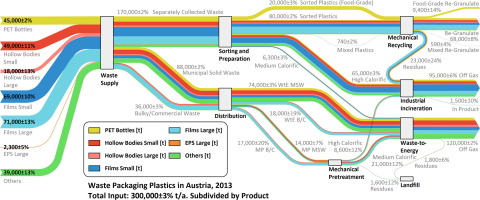
Abstract
Plastics, especially from packaging, have gained increasing attention in waste management, driving many policy initiatives to improve the circularity of these materials in the economy to increase resource efficiency. In this context, the EU has proposed increasing targets to encourage the recycling of (plastic) packaging. To accurately calculate the recycling rates, detailed information on the flows of plastic packaging is needed. Therefore, the aim of this paper is to quantitatively and qualitatively investigate the waste management system for plastic packaging in Austria in 2013 using material flow analysis, taking into account the used product types and the polymer composition. The results show that 300,000 ± 3% t/a (35 kg/cap·a) of waste plastic packaging were produced, mainly composed of large and small films and small hollow bodies, including PET bottles. Correspondingly, the polymer composition of the waste stream was dominated by LDPE (46% ± 6%), PET (19% ± 4%) and PP (14% ± 6%). 58% ± 3% was collected separately, and regarding the final treatment, 26% ± 7% of the total waste stream was recovered as re-granulates, whereas the rest was thermally recovered in waste-to-energy plants (40% ± 3%) and the cement industry (33% ± 6%). The targets set by the EU and Austria were reached comfortably, although to reach the proposed future target major technological steps regarding collection and sorting will be needed. However, the current calculation point of the targets, i.e. on the input side of the recycling plant, is not deemed to be fully in line with the overall objective of the circular economy, namely to keep materials in the economy and prevent losses. It is therefore recommended that the targets be calculated with respect to the actual output of the recycling process, provided that the quality of the output products is maintained, to accurately assess the performance of the waste management system.






